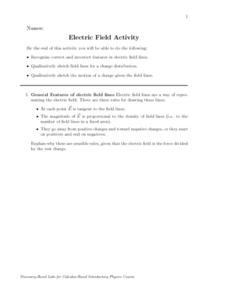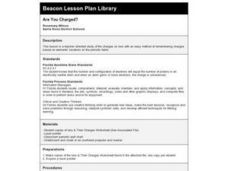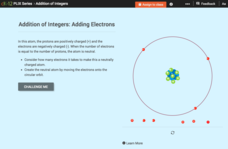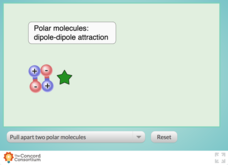Curated OER
Static Electricity
In this static electricity worksheet, students experiment with balloons, plastic bags and flannel clothes to observe attraction and repulsion of objects. Students complete three data tables indicating the charge on the objects and if...
Curated OER
Electric Field Activity
In this physics worksheet, students identify and describe the correct and incorrect features in electric field lines. Then they qualitatively sketch field lines for a charge distribution and a charge given the field lines.
Royal Society of Chemistry
Tests for Anions
The anode, the positive electrode, attracts negative charges, which is why we call negatively charged atoms anions. The interactive allows pupils to match six different anions to the associated properties when testing. Offering four...
American Chemical Society
Dissolving M-and-Ms
Learning ... how sweet it is! A hands-on lesson uses colored candies to demonstrate how positive and negative charges interact. Pupils use different types of liquids and watch as the color from the candies spreads—or doesn't.
Curated OER
Electrostatics
Middle schoolers examine ways positive and negative charges are attracted and repelled by watching teacher demonstrations, and complete activity sheet related to classroom demonstration activities to prove proficiency of knowledge of...
Curated OER
Are You Charged?
Fourth graders study the charges on ions and familiarize themselves with a quick way to remember charges based on location of elements on the periodic table. They complete a worksheet and share their answers with the class.
Curated OER
Static Electricity
In this static electricity worksheet, learners complete nine questions about electron charges, coulombs, potential energy, voltage and the Van de Graaf generator.
Curated OER
Getting A Charge Out of the Sky
Students investigate electricity from the sky. In this electricity lesson, students participate in an experiment to simulate the electric charges from the sky. Students discuss results.
Henrico County Public Schools
Models for Teaching Addition and Subtraction of Integers
Positive and negative numbers are everywhere in the world around us. Whether it's charged particles in atoms, a hot air balloon rising and falling in the sky, or a series of bills and checks being delivered in the mail, this resource...
Curated OER
What is an Electric Current?
In this electric current worksheet, students will write down three facts about electric currents. Based on these facts, students will come up with a conclusion as to what an electric current is.
CK-12 Foundation
The Real Numbers: Adding Electrons
Get a charge out of a great resource! Scholars use an interactive to explore addition and subtraction of integers. They add or remove electrons in an atom model to consider its charge.
Curated OER
More About Static Electricity
Students examine the concept that static electricity is a phenomenon that involves positive and negative charges. They explore the Static Electricity section of the Science, Technology and Engineering website to learn more about the...
Curated OER
Matter, Matter
Middle schoolers define vocabulary related to the parts of the atom. For this matter lesson, students navigate the web to find the structure and the forces that affect atoms. Middle schoolers complete an experiment with positive and...
Curated OER
Applied Science - Technology (3A) Pre Lab
Third graders discuss electric currents. In this circuit lesson, 3rd graders create a picture of a battery circuit and a light bulb. They show the positive and negative charge and the flow of electrons.
CK-12 Foundation
Addition of Integers: Adding Electrons
Young mathematical scientists interact with protons and electrons in an atom to create a neutrally charged atom. They answer questions based on their findings throughout the interactive resource.
Curated OER
Signed Numbers Word Problems
In this signed numbers learning exercise, students solve 10 different word problems that include using signed numbers in each problem. First, they determine the status of an account given the information stated in the problem. Then,...
Curated OER
Opposites Attract
Students examine the properties of magnets and static electricity. They participate in experiments that demonstrate the behaviors of charged particles, and record their data on a worksheet.
Curated OER
Electricity
In this electricity worksheet, high schoolers answer 17 questions about charges on atoms, their number of protons and electrons, the attraction of atoms or objects when charged, the electricity between two objects, grounding and insulating.
Curated OER
Charge Challenge
Learners observe the behavior of different charged objects. In this science lesson, students perform a series of static electricity experiments. They discuss their observations in class.
Concord Consortium
Comparing Dipole-Dipole to London Dispersion
Which intermolecular force is the strongest? Scholars test the relative strength of London dispersion forces, dipole-dipole interactions, and induced dipoles using a simulator. The interactive allows learners to pull on paired molecules...
Concord Consortium
Seeing Intermolecular Attractions
Ahh, the rules of attraction...intermolecular attraction! Introduce your chemistry crew to the other forces that influence the behavior of atoms and molecules alike with a simple interactive. Pupils push and pull polar and non-polar...
Concord Consortium
Polarity and Attractive Strength
Teaching intermolecular forces can be quite a stretch! Chemistry scholars experiment with the attractive strength between polar molecules using an interactive resource. Learners test molecules of low, medium, and high polarities by...
Concord Consortium
Opposites Attract
Whether they pull together or push away from one another, magnets are sure-fire pupil pleasers! Take their study of magnetism to a new level with a fun interactive. Individuals control the polarity of two spheres to observe attractive or...
Curated OER
Sensational Soil
Fourth and fifth graders explore soil by taking a simulated field trip under the earth. They go to an Internet site that runs a simulation which charges them with finding a source of pollution that could destroy all of Earth's soil, and...

























